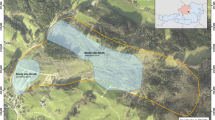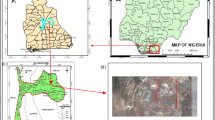Abstract
Unmanned aeronautical vehicle (UAV) is an inspiring novel remote-sensing tool fit for procuring high-resolution spatial information. Traditional methods of information gathering are not appropriate to detect subtle but important changes in erosion gully structure under low temporal and spatial resolutions. In this study a low-cost remote-sensing approach based on UAVs and advanced conservative cameras will be presented. The idea of manually operated four rotor helicopters was examined by photogrammetric uses, because four-rotor systems have been proven to be well appropriate for terrain observation in difficult highland area. Amid the UAV-based remote-sensing campaigns, critical quantities of airborne photographs of the Huoxiang gully in Chinese Loess Plateau (CLP) were obtained. These photographs were combined to an orthomosaic by image rectification techniques. Digital surface models (DSMs) were generated utilizing a new feature-based surface reconstruction method without any ground control point information. This approach can obtain high-resolution images of gully retrogressive erosion.








Similar content being viewed by others
References
Aber JS, Aber SW, Pavri F (2002) Unmanned small format aerial photography from kites acquiring large-scale, high-resolution, multiview-angle imagery. Int Archives of Photogramm Remote Sens and Spat Inf Sci 34:1–6
Aidi H, Lei Y, **** L, Yuxiang C, Jianbing P, Daniel N (2021a) Influence of landfill and land use scenario on runoff, evapotranspiration, and sediment yield over the Chinese Loess Plateau. Ecol Indic 121
Aidi H, Peng J, Yuxiang C, **** L, Zhixin Z, Chunli Z (2021b) Hydrological analysis of Loess Plateau highland control schemes in Dongzhi Plateau. Front Earth Sci 8:528632
Arya S, Mount DM, Netanyahu NS, Silverman R, Wu AY (1998) An optimal algorithm for approximate nearest neighbor searching fixed dimensions. J of the ACM (JACM) 45:891–923
Cheng J, Aidi H, **nghua Z, Hong W, **aolu Z, **aofan W (2019) Research status of loess hydraulic erosion-landslide-mudflow chain. J of Nat Disasters 28:38–43
Deren L, Ming L (2014) Research advance and application prospect of unmanned aerial vehicle remote sensing system. Geomat and Inf Sci of Wuhan Univ 39:505-513+540.
Eisenbeiss H, Lambers K, Sauerbier M Photogrammetric recording of the archaeological site of Pinchango Alto (Palpa, Peru) using a mini helicopter (UAV). In: CAA, 2005. pp 175-184.
Fischler MA, Bolles RC (1987) Random sample consensus: a paradigm for model fitting with applications to image analysis and automated cartography. In: Readings in computer vision. Elsevier, pp 726-740.
Fotinopoulos V Balloon photogrammetry for archaeological surveys. In: International Archives of the Photogrammetry, Remote Sensing and Spatial Information Sciences, XX ISPRS Congress, Istanbul, Turkey, 2004. p B5.
Huo A, Kang X, Wang G, Wu S, Wei J (2008) Model establishment of vegetation coverage extraction in sandy desertification area based on MODIS image data. Agric Res in the Arid Areas 26:217–223
Huo A-D, Dang J, Song J-X, Chen XH, Mao H-R (2016a) Simulation modeling for water governance in basins based on surface water and groundwater. Agr Water Manag 174:22–29
Huo A-D, Guan W-K, Dang J, Wu T-Z, Shantai H, Wang W, Liew MWV (2016b) Submerged area of typical torrential flood and debris-flow disasters in Mengzong Gully, China. Geomat, Nat Hazards and Risk 7:18–24
Huo A, Peng J, Chen X, Deng L, Wang G, Cheng Y (2016c) Groundwater storage and depletion trends in the Loess areas of China. Environ Earth Sci 75:1167
Huo A, Zhang J, Cheng Y, Yi X, Qiao L, Su F, du Y, Mao H (2016d) Assessing the effect of scaling methods on retrieval of soil moisture based on MODIS images in arid regions. Toxicol & Environ Chem 98:410–418
Jütte K (2008) Vergleich verschiedener low-cost Luftbildaufnahmesysteme sowie Einsatz von Drohnen: Grenzen und Möglichkeiten. Der gepixelte Wald-Fachtag zur forstl Fernerkund
Kun Y, Jie S, Zhiming W, Bihui L, Lin Q, Liangjun M (2019) Land use status monitoring in small scale by unmanned aerial vehicles (UAVs) observations. Jiangsu J of Agric Sci 35:853–859
Lee J (1982) Well testing. Society of Petroleum Engineers, New York
Lei Y, Shuqiang L, Hongying Z, Xuehu Z, Shaowen Y, Jicheng Z (2004) Research on key techniques of aerial remote sensing system for unmanned aerial vehicles. Eng J of Wuhan Univ:67-70.
Lei T, Li C, He X (2011) Application of aerial remote sensing of pilotless aircraft to disaster emergency rescue. Journal of Natural Disasters 20:177–184
Lin F, Binbing L (2018) Establishment of high precision terrain model of eroded gully with UAV oblique aerial photos and ground control points. Trans of the Chin Soc of Agric Eng 34:88–95
Lowe DG (2004) Distinctive image features from scale-invariant keypoints. Int J of comput vis 60:91–110
Matthews CS, Russell DG (1967) Pressure buildup and flow tests in wells vol 1.
Niethammer M, Sieber M, Von HS, Anker SD, Munzel T, Horstick G, Genth-Zotz S (2008) Inflammatory pathways in patients with heart failure and preserved ejection fraction. Int J of Cardiol 129:111–117
Peng J, Fan Z, Wu D, Zhuang J, Dai F, Chen W, Zhao C (2015) Heavy rainfall triggered loess–mudstone landslide and subsequent debris flow in Tianshui, China. Eng Geol 186:79–90
Peng J, Huo A, Cheng Y, Dang J, Wei H, Wang X, Li C (2017) Submersion simulation in a typical debris flow watershed of Jianzhuangchuan catchment, Loess Plateau. Environ Earth Sci 76:462
Przybilla H, Wester-Ebbinghaus W (1979) Bildflug mit ferngelenktem Kleinflugzeug. Bildmess und Luftbildwes 47:137–142
Tang Q, Zhang X, Tang Y (2013) Anthropogenic impacts on mass change in North China. Geophys Res Lett 40:3924–3928
Weiwei S, Gang Y, Chao C, Minghui C, Ke H, **angzhen M, Liangyun L (2020) Development status and literature analysis of China’s earth observation remote sensing satellites. J of Remote Sens 24:479–510
**oafan W, Aidi H, **nghua Z, Yanbin Z, Cheng J, **aolu Z (2019) Study on governance mode of gully consolidation and highland protection project in East Gansu. Yellow River 41:106–109
Xu L, Dai F, Tu X, Tham LG, Zhou Y, Iqbal J (2014) Landslides in a loess platform, North-West China. Landslides 11:993–1005
Zhang X, Lu Y, Li X, Lu Y, Sun J, Pan W, Hatfield K (2019) Multilevel collapsibility of Loess under irrigation in **ya Town, Gansu Province, China. Adv in Civ Eng 2019.
Zhao G, Mu X, Wen Z, Wang F, Gao P (2013) Soil erosion, conservation, and eco-environment changes in the loess plateau of China. Land Degrad & Dev 24:499–510
Acknowledgements
We would like to thank the reviewers and editor for their constructive comments, which helped to significantly improve the manuscript.
Funding
This work was supported by the National Natural Science Foundation of China (Grants No. 41790444, 41877232 and 41672255) Key R & D projects of Shaanxi Province (Grants No. 2020SF-424); and Key Laboratory Open Project Fund of State Key Laboratory of Loess and Quaternary Geology, Institute of Earth Environment, CAS (Grants No. SKLLQG1909); the General Financial Grant from the Shaanxi Natural Foundation of China (2019JM-297); ;the General Financial Grant from the China Postdoctoral Science Foundation (2017M623088) and the General Financial Grant from the Shaanxi Postdoctoral Science Foundation 2018 (2018BSHEDZZ21).
Author information
Authors and Affiliations
Corresponding author
Ethics declarations
Conflict of interest
The authors declare that they have no conflict of interest.
Additional information
Responsible Editor: Biswajeet Pradhan
Highlights
• UAV method reveals high-resolution DSM for gully retrogressive erosion monitoring;
• Novel DSMs acquisition method without any ground control point;
• The method can obtain high precision gully retrogressive erosion.
This paper was selected from the 2nd Conference of the Arabian Journal of Geosciences (CAJG), Tunisia 2019
Rights and permissions
About this article
Cite this article
Aidi, H., Siming, C., Jianbing, P. et al. UAV-based gully retrogressive erosion status dynamic variability investigations in Chinese Loess Plateau. Arab J Geosci 14, 263 (2021). https://doi.org/10.1007/s12517-021-06580-y
Received:
Accepted:
Published:
DOI: https://doi.org/10.1007/s12517-021-06580-y




